Sealed FateS
 Preface
Preface
By Jeff Stone
Many of you, like me, spend way too many hours on The Magic Cafe. However, often the time is well spent.
Were it not for time spent on the cafe, I would never have come across Iain Dunford’s post regarding a pdf from a friend of his, Kate Cuttler aka “The Queen of Clubs.”
The PDF is called Sealed FateS, and Kate has given Stone Cold Magic permission to publish it here as September’s Free Trick of The Month.
Let me warn you right up front. When you read this effect, you may be tempted to modify the handling. Don’t do it! The handling was very carefully thought out to create a very specific effect. Changing the handling, changes the effect. Trust me. Here it is in her own words:
Quick Introduction:
Thank you for requesting the explanation for Sealed fateS! This is my (Queen of Clubs’) first effect and hopefully there’ll be plenty more in the future.
The effect evolved from a technique I came across that allowed the magician to force a particular card on a spectator in an extremely fair seeming manner – that is by giving them an X card and inviting them to push it into the deck anywhere they liked as he spread through the cards in his hands. The card directly above or below (depending on the magician’s preference) would be the force card. I was very excited about the move simply because it looked so completely fair in comparison to other forces – with the possible exception of the difficult and sometimes fallible classic force – yet it was relatively simple to achieve.
I decided it deserved to be framed by an effect, so Iain Dunford and I did a little bit of thinking and came up with the presentation described below, where a sealed envelope contains a two-card prediction that, of course, turns out to be spot on.
For a variety of reasons I’ve decided that I won’t be selling this. I’d prefer to offer it for free to any card magician who shows an interest. This way, people can get an idea of the sorts of effects and the sorts of quality of work I might put out in the future. At the moment I have no reputation to speak of and I’m not a working professional so it makes more sense to me to put this effect out at the bargain price of £0.00.
I hope I didn’t overprice it. Please enjoy.
– Queen of Clubs
How it Plays for the Spectators:
“A deck of cards and a sealed envelope are placed on the table. This is not a random act of table-cluttery; you’re about to do a trick. You ask the spectator to keep possession of the envelope as you give the deck a casual shuffle.
The spectator picks a number. You explain that it can be any number between one and fifty-two; it doesn’t really matter because fate has already decided the outcome. You slowly deal cards from the bottom of the deck, explaining that they all need to be kept face down for now, so we’re not going to try and peek at any of them. When you arrive at the spectator’s chosen number you deal the card face down in front of them, gathering the rest back up.
Reminding them that this about fate, you widely spread through the face down deck in your hands and tell them that you want them to take their face down card and slip it into the deck at any point as you spread through, but not to push it in all the way – just to leave it out jogged half its length like a place marker – and in that way a second card will be randomly selected.
Once they’ve stuck their card into the deck you square up and table it with their out jogged card somewhere in the middle. All of this is fair and random? Yes? Yes.
You ribbon spread the deck on the table and openly and fairly separate their out jogged first selection and the card directly below it (which will become selection two) and remind them of the process that has just occurred: they freely selected a number; we dealt to the corresponding card; that card was used by them to freely select a second card; both cards have remained face down and are a mystery.
You spread the rest of the deck face up on the table to show it is a genuine deck of playing cards while their two selections remain face down. The spectator is then invited to open the sealed envelope. Inside is a folded slip of paper on which you’ve written ‘You will choose the Two of Hearts and the Jack of Diamonds’. By now it’s probably time to turn over the Two of Hearts and the Jack of Diamonds, which you’ll find located face down in front of your spectator.”
Set up and preparation:
Great news! This effect can be done totally impromptu; even with a borrowed deck. There are no fancy gaffs, gimmicks or difficult switches and the spectators can burn the deck with their eyes all they wish. However, my preferred method does require a very small amount of preparation:
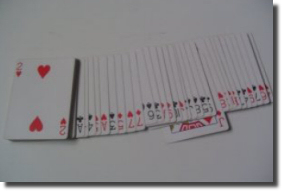
Set the deck up as shown in the image to the left, with the Two of Hearts on the very bottom and the Jack of Diamonds ten cards from the top. It should be obvious, by the way, that you can use any two cards you prefer (Iain suggests an ESP deck for a variation of the same effect), but for the sake of simplicity and clarity in this explanation I will refer to the first selection as the Two and the second as the Jack.
In addition to this, I suggest that you place a light pencil dot in the bottom corners of the back of whatever card is directly above the Jack. This will be explained shortly, but basically you will need to be able to immediately identify the position of the Jack during an in the-hands ribbon spread. You can pencil dot the Jack if you wish, but you end cleaner by dotting the card beside it, since your spectator may wish to examine both prediction cards after the effect.
I’ll explain how to by-pass the pencil dot preparation with the impromptu handling at the end of this document.
Just a Minute!
Before we get into the explanation I’d like to quickly point out a couple of things:
Firstly the ‘casual shuffle’ mentioned in the description. This is optional. I like to give the deck a very brief overhand false shuffle that retains complete deck order, just to add that extra bit of illusion of a random deck. I won’t teach any false shuffles here, though, as you can learn them elsewhere, but just be aware that the shuffle I mention is false. No cards change position.
Secondly I am left-handed. This really shouldn’t make a great deal of difference as long as you are aware of that and take it into account when you look at the photographs and video. When you see me holding a packet in my left and realise that you’d prefer to do it in your right, it’s because I’m ‘special’. Just reverse the handling to your preferred hands.
Forcing Selection 1 (Two of Hearts):
Now, the first force (with the spectator being asked to name out loud a random number which you then deal to) is achieved by using the glide. I feel this is a very under-rated sleight and in the right circumstances it works perfectly. I’ve heard magicians say the glide is a weak move, but with this particular effect – where the second force is so impossible for a spectator to understand and the overall payoff hopefully so strong – the glide will… well, glide by seamlessly. After all, it’s about what the audience remembers, not how you achieve it.
Here’s a brief explanation of the move for those who may be unaware of it:
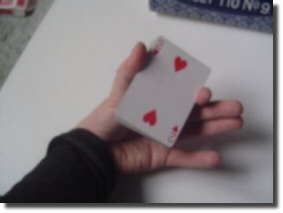
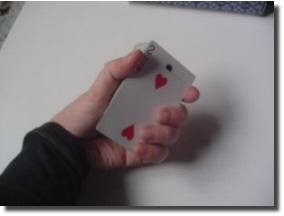
Grip the deck as shown above (but face down) The ring finger, guided by the other fingers and thumb, glides the bottom card back slightly (above pic). Because the deck is held in a wrist-killed position with the cards face down and the magician’s hand coming over the top, it should be impossible for the spectator to notice the out-jog (work on angles if you find this isn’t the case).
From this position you can appear to be dealing from the bottom of the deck when in fact you are retaining the Two of Hearts and dealing the cards in second from bottom position. If the spectator says “Nine”, then deal eight X cards from the glide position and on the ninth simply reach a little further under and take the Two of Hearts. Deal this “random” card face down in front of your spectator as you gather the deck back together and continue your patter.
Forcing Selection 2 (Jack of Diamonds):
Now we’re getting to the cool bit. How on Earth can a spectator take a face down card and insert it out-jogged into the ribbon as you perform an in-the-hands spread and ALWAYS place it directly above the correct card?! Well, it’s a very cheeky use of the cull.
Very basic summary: As you spread face down you spot the Jack (pencil dot, remember?) and immediately cull it under the spread. Wherever they insert their card you load the Jack underneath their out-jog in the motion of immediately closing and tabling the deck.
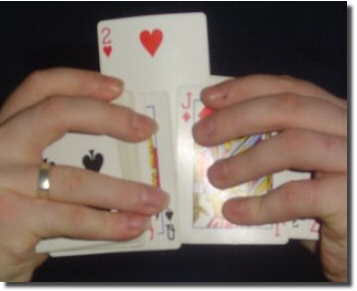
The above picture shows the view from underneath as the culled Jack gets loaded directly under the Two. Don’t make a big deal out of this. You should be loading in the same motion of immediately closing the spread and tabling the deck after your spectator has randomly inserted the Two.
 Finishing the Effect (The Rest is Just Acting):
Finishing the Effect (The Rest is Just Acting):
The deck is immediately tabled with selection 1 out-jogged (left). At this point you should re-cap to the spectator to cement in their minds that what has just happened was completely fair. “You picked a random number. I didn’t try and force you to go for a certain number? No? Then we dealt to that card. Then you pushed that card into the deck at a completely random point? Yes? Did you feel drawn to that particular spot? Well… hopefully fate is on our side.”
Insert your own patter, of course. Don’t feel that you have to go down the “fate” road. That’s just something I like to talk about during the performance to build up to the opening of the sealed envelope.

Then you spread the cards on the table (left image). I recommend doing a reverse spread to hide any pencil dots if you’ve used them. When you isolate the two selections make sure to do it slowly and fairly so nobody can accuse you later of somehow switching the cards.
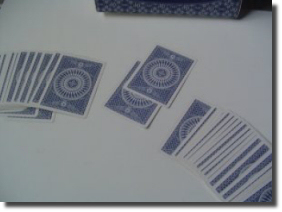 If you like you can turn over the rest of the deck to show it’s just a regular set of playing cards, but leave the two selections face down as you’ll want the spectator to open the envelope first.
If you like you can turn over the rest of the deck to show it’s just a regular set of playing cards, but leave the two selections face down as you’ll want the spectator to open the envelope first.
I won’t go into envelopes, folded sheets of paper and all that. Have the sealed prediction as you see fit – however it works best for you or whatever best suits your style of performance.
Impromptu Handling:
So… I promised this effect can be done completely impromptu and even with a borrowed deck. Here is how I suggest the handling should be approached:You explain that you’d like to try something; an experiment in psychology or a demonstration of the inevitability of fate, etc. You have a deck and a piece of paper handed to you. You give the deck a shuffle and spread through it in your hands. This looks like you’re just making sure it’s a complete deck. Then you write your predictions and fold the paper. Write the names of two cards somewhere near to each other towards the middle of the deck (and don’t forget them!!!)
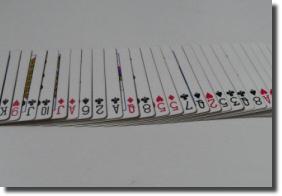 They should be roughly ten cards apart and in the orientation demonstrated to the left. As you look at this spread, imagine for the sake of simplicity that the two cards you decide on as your predictions are the same as in this entire document – selection 1 being the Two of Hearts and selection 2 being the Jack of Diamonds. You see the Jack, and roughly ten cards along is the Two.
They should be roughly ten cards apart and in the orientation demonstrated to the left. As you look at this spread, imagine for the sake of simplicity that the two cards you decide on as your predictions are the same as in this entire document – selection 1 being the Two of Hearts and selection 2 being the Jack of Diamonds. You see the Jack, and roughly ten cards along is the Two.
The two cards you choose should be roughly in those positions, because what you are going to do is first crimp the Jack (I’ll explain shortly) and then cut the deck at the Two. As you’ll see from the picture to the left, cutting at the Two would bring the Two to the very bottom of the deck and the Jack roughly ten from the top – our original set up for the effect.
You can either just casually cut as you patter, or you might prefer to execute a turn-over pass if you’d prefer it to be totally invisible. Now on to the crimp. Because you can’t pencil dot a card yet you need to still be able to spot the Jack (or whichever card you’ve chosen for the impromptu performance) in a face down spread to cull it, you’ll need to make it identifiable some other way.
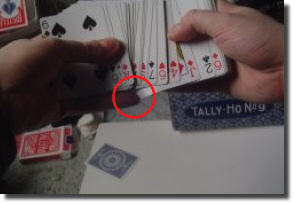 Before you cut/turnover pass the deck, spread through and perform the following move: The pinkie lays along the bottom of the spread as if to guide the cards along. Choose a card to crimp and allow the pinkie to give it a slight bend as seen to the left.
Before you cut/turnover pass the deck, spread through and perform the following move: The pinkie lays along the bottom of the spread as if to guide the cards along. Choose a card to crimp and allow the pinkie to give it a slight bend as seen to the left.
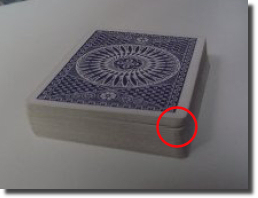 After you’ve crimped and noted a card, spread along around ten more cards, note that one also, and then cut it to the bottom. To the left you see the resultant crimp in a squared deck. As it is facing you and not your audience this should not cause a problem.
After you’ve crimped and noted a card, spread along around ten more cards, note that one also, and then cut it to the bottom. To the left you see the resultant crimp in a squared deck. As it is facing you and not your audience this should not cause a problem.
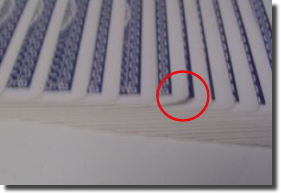 As you can see here, the crimp is easy to spot as you spread through the deck. No chance of culling the wrong card. If your deck is brand new then the crimp can be very subtle, but with a more worn deck you will need to judge the amount you bend the card.
As you can see here, the crimp is easy to spot as you spread through the deck. No chance of culling the wrong card. If your deck is brand new then the crimp can be very subtle, but with a more worn deck you will need to judge the amount you bend the card.
Too little and you might mistake it for an X card that just happens also to be a bit bent from general use. Although this took a lot to explain, you should be able to do everything above within a few seconds under the guise of “checking” the deck, after which you table it face down and scribble your predictions on the billet. You’re ready to perform impromptu!
Alternative presentations:
Iain, being more of a mentalist than a cardie, has suggested an alternative presentation that uses the same handling as I’ve described above. The difference is you use a deck of 25 ESP cards. Inside your sealed envelope you have a folded billet that says “Today I will try to project the Circle”. A Circle card from the deck is also sealed inside the envelope. This can be performed twice (two separate spectators) before the envelope is opened, leaving four face down cards on the table (all circles, of course) and the final circle inside the prediction envelope, therefore all five Circles from the deck have been accurately found under seemingly impossible circumstances.
Final Words:
Thank you again for reading Sealed fateS. I hope you’re pleased with the effect, or at the very least have got something positive out of this effect. The cull and load can be used for so many other effects – all you need to do is dream them up – so hopefully people will keep the move in mind and maybe even incorporate it into their work in some way.
You can email me at katykins.com@gmail.com if you have any comments, or you can catch me (Queen of Clubs) and Iain Dunford on various magic forums including Talk Magic Feel free to post up reviews of this on your favourite magic sites and if you liked it – spread the word.
Please “like” This Effect:
